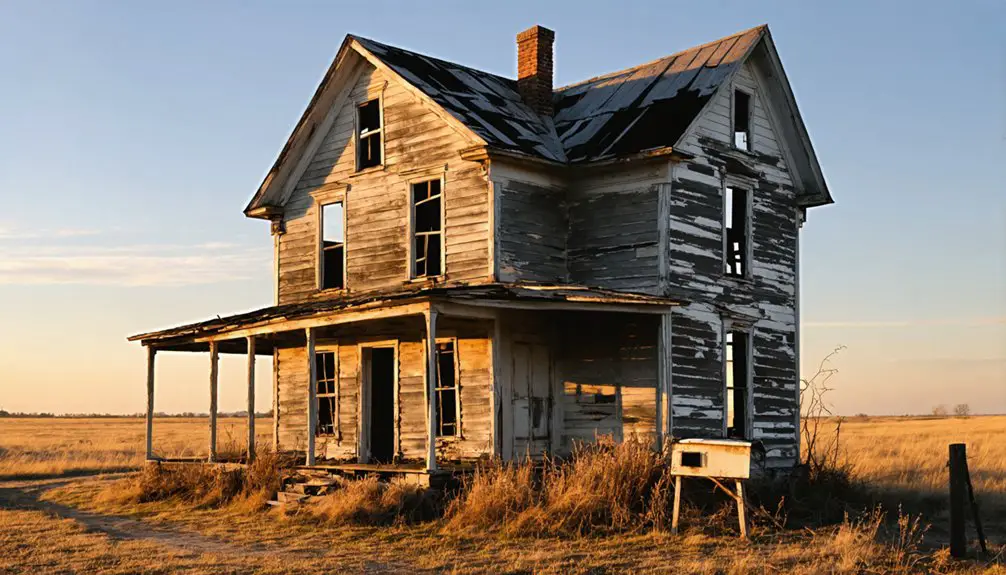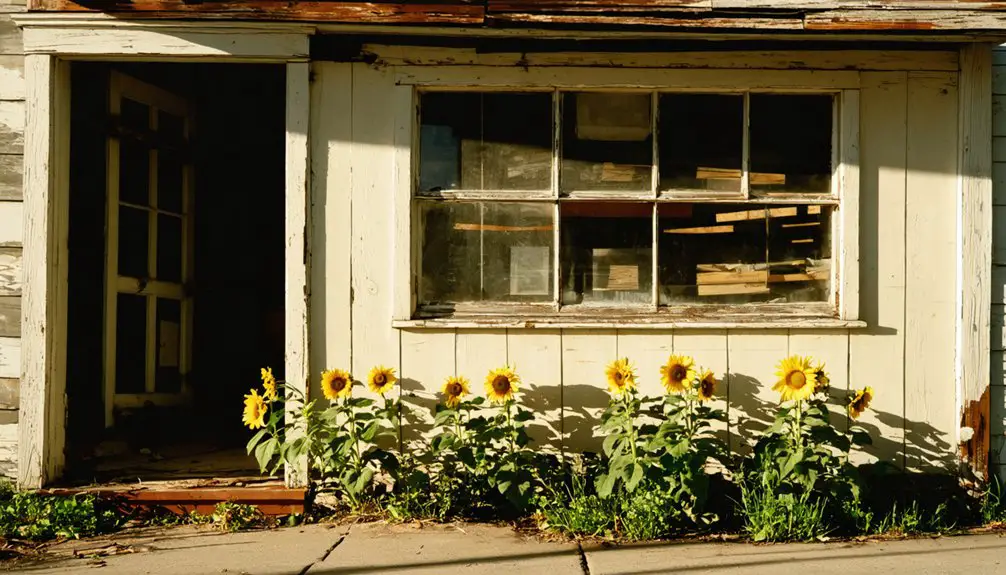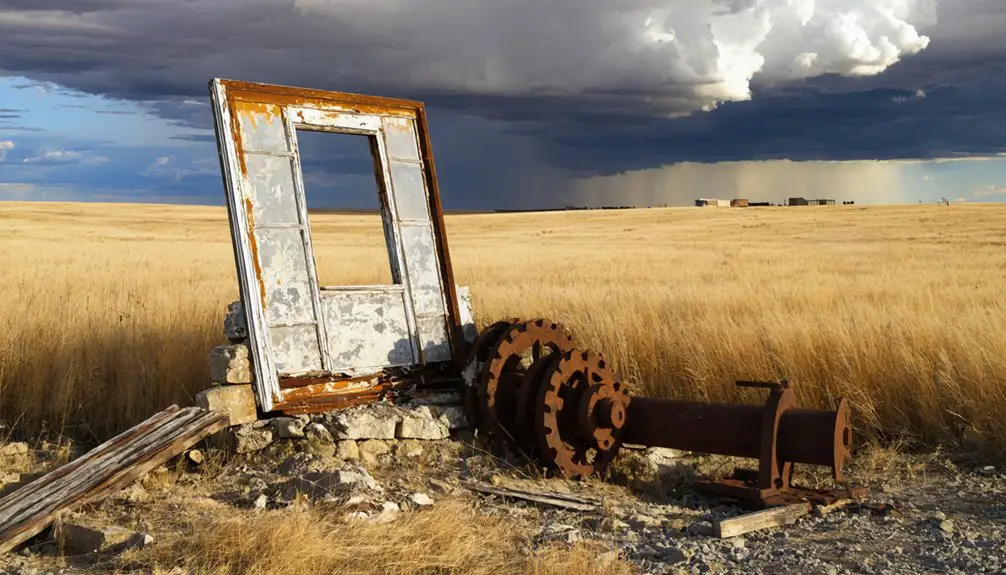You’ll find Reece, Kansas 7.5 miles west of Eureka in Greenwood County. Originally called Collins when its post office opened in 1870, the settlement adopted the name Reece in 1883, reflecting its Welsh heritage. The community thrived as an agricultural hub along the Missouri Pacific Railroad, reaching 100 residents by 1910. While the post office’s closure in 1975 marked the town’s decline, Reece’s frontier legacy holds fascinating tales of pioneer life and rural postal operations.
Key Takeaways
- Reece, Kansas became a ghost town following severe environmental contamination from lead and zinc mining activities in the 1950s.
- The town’s post office, which operated from 1870 to 1975, closed after over a century of service to the rural community.
- Toxic contamination led to the town’s designation as a Superfund site, causing property values to plummet and residents to abandon their homes.
- Located 7.5 miles west of Eureka in Greenwood County, Reece began as “Collins” in 1870 before being renamed in 1883.
- Despite physical abandonment, the town’s history is preserved through museum exhibits, archived materials, and oral history collections.
Origins and Early Settlement
When settlers first established a presence in southwest Greenwood County, Kansas, they marked their arrival with the opening of the Collins post office on December 8, 1870.
You’ll find that these early pioneers faced significant challenges as they carved out homesteads in this untamed frontier territory. The post office served as a crucial lifeline, connecting settlers to the outside world during the post-Civil War expansion.
Life on the frontier demanded resilience, with the humble post office bridging isolated homesteaders to civilization beyond the plains.
As you explore the area’s history, you’ll discover that agricultural practices dominated daily life, with families engaging in farming and cattle ranching to sustain themselves. The community was strategically positioned along the Missouri Pacific Railroad, though this advantage did not spur significant growth. The area would later become known for its rich deposits of zinc and lead that transformed the region’s economy.
On January 29, 1883, the settlement’s name changed from Collins to Reece, reflecting the evolution of this growing frontier community. The unincorporated rural settlement exemplified the broader movement of Americans seeking new opportunities across the Great Plains.
From Collins to Reece: A Name’s Evolution
As southwest Kansas settlements evolved in the late 19th century, the small frontier outpost of Collins underwent a significant transformation with its 1883 renaming to Reece.
You’ll find the name significance tied to Welsh origins, derived from “Rhys,” meaning enthusiasm or ardor – a shift from the more generic “Collins” to a distinctive community identity. Similar to other disambiguation terms like Recce and Rees, the name has multiple historical variants.
The change became official on January 29, 1883, when the post office, originally established in 1870, adopted the new name. Much like the post office of Altamont, which changed its name from Elston in 1875, these changes reflected the evolving identities of Kansas communities.
While the Missouri Pacific Railroad provided essential connections to regional networks, Reece’s growth remained modest, reaching only 100 residents by 1910.
The post office continued serving the area until 1975, marking over a century of service.
Today, you’ll find Reece as an unincorporated community, 7.5 miles west of Eureka.
Life in Early Reece
In early Reece, you’d find a rural postal system that served both the town’s hundred residents and surrounding farmers through a dedicated mail route.
You could visit the money order post office, which operated alongside telegraph and express offices, making Reece an essential communications hub for the area’s pioneer families.
Your daily encounters would include farmers collecting mail and supplies at the mercantile establishments, reflecting the typical settlement patterns of early rural Kansas communities. Residents often needed to consult navigational aids to find their way between similar-sounding nearby settlements. Like many Kansas towns of the era, Reece faced challenges from bad weather that tested the resilience of its pioneer population.
Daily Rural Postal Operations
Through decades of continuous operation, the Reece post office served as the town’s essential communication hub, starting as “Collins” in December 1870 before its renaming to “Reece” in January 1883.
As your rural communication lifeline, this significant outpost offered money orders, express shipping, and telegraph services by the early 1900s. You’d find the post office bustling with activity as farmers and residents gathered to collect mail and exchange news. Rural mail carriers functioned as traveling post offices, selling stamps and money orders directly to residents.
The introduction of Rural Free Delivery transformed your postal community, bringing mail directly to scattered farmhouses across the countryside. Your dedicated rural carriers became trusted figures, navigating dirt roads in all weather conditions to maintain this important connection.
With standardized mailboxes and improved roads, you’d receive regular deliveries that kept you connected to the wider world until the office’s closure in the late 1960s.
Pioneer Settlement Patterns
The post-Civil War era brought settlers like Sanford and Lowell Reese to McPherson County in 1866, marking the beginning of Reece’s pioneer story.
You’d find these early pioneers walking alternately with a single horse, searching for ideal quarter sections near water sources like Gypsum Creek.
Pioneer migration patterns followed natural features, with settlers staking claims on unsurveyed land where buffalo still roamed freely.
Settlement challenges were constant – you’d build simple sod houses or log cabins measuring 12 by 16 feet, dig primitive wells from creek beds, and rely on distant supply runs to Atchison, 160 miles away. Early settlers like David Reece supported their families through milk and butter from their cows.
The 1860 drought caused severe hardship for early settlers, with many facing near starvation conditions.
As communities formed, you’d find scattered homesteads gradually clustering around shared resources like springs, creating small population centers that rarely exceeded 100 residents, even after railroad access arrived by 1910.
The Post Office Era
If you’d traveled through rural Kansas in late 1870, you’d have found the newly established Collins post office serving the scattered agricultural community along the Missouri Pacific Railroad line.
By January 1883, you’d have witnessed the post office’s name change to Reece, reflecting the community’s evolving identity and growing connections to the broader region.
During its 97-year run, you’d have seen the post office expand to include rural mail routes, money order services, and telegraph capabilities, making it a crucial communications hub for the area’s residents until its closure in 1967. Like many small-town America remnants across Kansas, Reece eventually succumbed to the widespread decline that affected thousands of rural communities after World War II.
Early Postal Service Beginnings
On December 8, 1870, postal services arrived in what would become Reece when a small post office opened under the name Collins.
This marked the beginning of a crucial community hub that would serve the area’s residents for nearly a century.
The postal service operated under the Collins name for thirteen years until January 29, 1883, when it officially changed to Reece to match the town’s identity.
Collins to Reece Transition
During its formative years between 1870 and 1883, Reece’s identity emerged through a significant postal change from Collins to its permanent name.
You’ll find the Collins history began when the post office first opened on December 8, 1870, serving as a crucial communication hub alongside the Missouri Pacific Railroad line. The transformation to the Reece identity became official on January 29, 1883, marking a pivotal moment in the settlement’s evolution.
This newly named Reece post office would go on to provide essential services for over 80 years, offering money orders, telegraph access, and rural mail delivery to the surrounding agricultural community.
The office became central to daily life, working in tandem with the railroad to connect residents to the wider world through express mail and goods transport.
Rural Mail Route Legacy
While Reece’s post office operated under its original name of Collins in 1870, the establishment would soon become an essential lifeline for rural residents through its expanded mail delivery services.
By the late 19th century, postal innovations transformed rural connectivity in Greenwood County. The introduction of Rural Free Delivery routes revolutionized how you’d receive mail if you lived on a remote farm or homestead.
Key developments that shaped Reece’s postal legacy:
- Telegraph services and money orders expanded the post office’s role beyond basic mail delivery
- RFD routes brought daily mail service directly to isolated homes and farms
- Express offices facilitated commercial transactions for the agricultural community
Despite having only 100 residents by 1910, Reece’s post office remained a crucial communication hub until its closure in 1967.
Geographic and Natural Features
Located in southwest Greenwood County, Kansas, Reece sits approximately nine miles southwest of Eureka, the county seat.
You’ll find the ghost town nestled in gently rolling prairie, where geological formations reach an elevation of 840 feet above sea level. The landscape reflects generations of agricultural practices, with fertile soil supporting both crops and pastureland.
Two creeks converge near the town’s original boundaries, their seasonal flows carving through the terrain. While the original prairie grasses and deciduous trees have largely given way to farmland, you can still spot patches of woodland along these waterways.
The town’s 0.1 square mile footprint experiences four distinct seasons, with humid summers perfect for growing crops and cold winters that can bring occasional snowfall.
The Missouri Pacific Railroad‘s old route serves as a reminder of Reece’s transportation history.
Decline and Abandonment

As the mining industry that once sustained Reece began faltering in the 1950s, the town’s fate was sealed.
The economic decline hit hard as mining companies went bankrupt or abandoned operations, leaving behind a toxic legacy of lead and zinc contamination.
The abrupt exodus of mining operations devastated not just the economy, but left a poisonous inheritance of toxic metals in their wake.
The environmental impact was devastating, leading to three major consequences:
- Widespread soil and water pollution made the area virtually uninhabitable
- Health problems among residents forced many families to relocate
- Property values plummeted as the town earned a Superfund site designation
Historical Preservation Efforts
Despite traditional preservation being impossible due to toxic contamination, determined efforts emerged to document and memorialize Reece’s legacy before its complete demolition.
You’ll find the town’s intangible heritage preserved through StoryCorps interviews, documentaries, and radio programs that captured residents’ experiences facing relocation.
Local museums and heritage centers, including the Kansas State Historical Society and Baxter Springs Heritage Center, have safeguarded historical photographs, mining records, and artifacts salvaged before demolition.
While you can’t visit the original buildings due to health hazards and EPA-mandated cleanup, community memory lives on through museum exhibits and archived materials.
These resources continue to educate future generations about the impact of mining on small towns and serve as powerful reminders of environmental consequences on rural communities.
Local Stories and Legends

While preserving physical artifacts tells one part of Reece’s story, the oral histories and local tales paint a more intimate portrait of this former Kansas settlement.
Like many ghost towns, Reece’s local folklore centers around the daily lives of resilient pioneers who called this remote outpost home.
Beyond buildings and ruins, Reece’s heart beats in the stories of its hardy settlers who built lives far from civilization.
Despite the scarcity of documented ghost sightings or supernatural tales, you’ll find the town’s real stories are just as enchanting:
- The 1883 shift from Collins to Reece marked a pivotal moment when locals seized control of their identity.
- The Missouri Pacific Railroad brought fresh faces and tales of adventure from distant lands.
- The post office served as the heart of local gossip and news sharing until its closure in 1967.
These stories echo through time, preserving the spirit of this agricultural community.
Modern-Day Site Exploration
Today’s visitors to Reece will find a quiet rural landscape where Kansas pioneers once carved out their lives along the Missouri Pacific Railroad line.
You’ll discover scattered homesteads and agricultural fields where businesses and a bustling railroad stop once stood. For ghost town photography, you’ll want to explore during early morning or late afternoon when lighting best captures the remaining structures and natural reclamation.
Essential exploration tips: Pack water and supplies, as there aren’t any services nearby.
You’ll need to navigate county roads off the main highways near Eureka to reach the site. Plan your visit around weather conditions, as unpaved roads can become challenging.
While exploring, you’re likely to encounter wildlife and naturally restored prairieland where the town once thrived.
Frequently Asked Questions
Were There Any Notable Crimes or Lawlessness in Reece’s History?
You won’t find documented crime rates or major lawlessness in Reece’s history. Unlike nearby mining towns with wild reputations, this small farming community operated without notable law enforcement issues.
What Businesses or Stores Operated in Reece During Its Peak?
Like spokes on a wagon wheel, Reece’s economy revolved around your basic needs: a general store, post office, blacksmith shop, telegraph office, and express services serving the Missouri Pacific Railroad line.
Did Any Famous People Ever Visit or Live in Reece?
You won’t find any famous visitors in historical records of this small farming town. Its historical significance remains purely local, focusing on everyday rural life rather than notable personalities.
What Happened to the Buildings and Structures After Abandonment?
You’ll find most buildings fell into natural decay without historical preservation efforts. Scattered homes remain standing, but public buildings and businesses deteriorated completely. The post office’s closure in 1967 marked widespread abandonment.
Were There Any Schools or Churches Established in Reece?
Like pillars of community life, you’ll find that both schools and churches were indeed established in town, serving residents through the early 1900s until their eventual closure during the settlement’s decline.
References
- https://legendsofkansas.com/reece-kansas/
- https://porzucki.com/Treece-KS-Ghost-Town-in-the-Making
- https://en.wikipedia.org/wiki/Treece
- https://www.hhhistory.com/2019/05/ghost-towns-of-kansas.html
- https://www.businessinsider.com/photos-of-ghost-town-treece-kansas-2017-4
- https://www.businessinsider.com/photos-of-ghost-town-treece-kansas-2015-12
- https://en.wikipedia.org/wiki/Reece
- https://www.ksgenweb.org/archives/labette/1901/260-263.html
- https://www.myheritage.com/names/amos_reece
- https://www.ssa.gov/oact/babynames/popularity_increase.html



